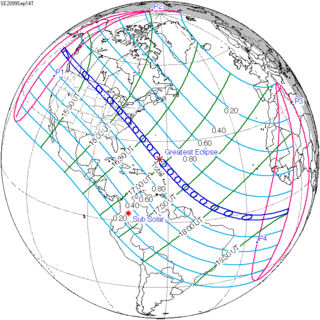
Summary
A total solar eclipse will occur on Monday, September 14, 2099. A solar eclipse occurs when the Moon passes between Earth and the Sun, thereby totally or partly obscuring the image of the Sun for a viewer on Earth. A total solar eclipse occurs when the Moon's apparent diameter is larger than the Sun's, blocking all direct sunlight, turning day into darkness. Totality occurs in a narrow path across Earth's surface, with the partial solar eclipse visible over a surrounding region thousands of kilometres wide.
| Solar eclipse of September 14, 2099 | |
|---|---|
 Map | |
| Type of eclipse | |
| Nature | Total |
| Gamma | 0.3942 |
| Magnitude | 1.0684 |
| Maximum eclipse | |
| Duration | 318 s (5 min 18 s) |
| Coordinates | 23°24′N 62°48′W / 23.4°N 62.8°W |
| Max. width of band | 241 km (150 mi) |
| Times (UTC) | |
| Greatest eclipse | 16:57:53 |
| References | |
| Saros | 136 (42 of 71) |
| Catalog # (SE5000) | 9732 |
Locations experiencing totality edit
It will begin at sunrise off the western coast of Canada, and move eastern across Canada (British Columbia, Alberta, and Saskatchewan) and the northern states of the United States (North Dakota, Minnesota, Wisconsin, Illinois, Indiana, Michigan, Ohio, Pennsylvania, West Virginia, Virginia and North Carolina). The eclipse will end in the Atlantic ocean, with partial visibility in parts of Europe, West Africa and throughout the entirety of North and South America.
The path of totality will pass through the cities of Madison, Wisconsin, and Grand Rapids, Michigan. The last time totality was visible over these two locations was respectively May 16, 1379,[1][2] and April 18, 1558.[3]
British Columbia edit
Alberta edit
Saskatchewan edit
Montana edit
North Dakota edit
Minnesota edit
Wisconsin edit
Illinois edit
Michigan edit
Indiana edit
Ohio edit
Pennsylvania edit
West Virginia edit
Virginia edit
North Carolina edit
Although this solar eclipse does pass over a few large cities such as Minneapolis and Virginia Beach, it fails to offer totality in several major cities nearby, including most of Chicago and all of Washington D.C., Detroit, Cincinnati and Cleveland.[4] Moreover, in Canada, the cities of Moose Jaw and Regina will be directly north of the path, but not in it.
Related eclipses edit
Solar eclipses 2098–2100 edit
This eclipse is a member of a semester series. An eclipse in a semester series of solar eclipses repeats approximately every 177 days and 4 hours (a semester) at alternating nodes of the Moon's orbit.[5]
| Solar eclipses 2098–2100 | |||||
|---|---|---|---|---|---|
| 121 | April 1, 2098 Partial |
126 | September 25, 2098 Partial | ||
| 131 | March 21, 2099 Annular |
136 | September 14, 2099 Total | ||
| 141 | March 10, 2100 Annular |
146 | September 4, 2100 Total | ||
Saros 136 edit
Solar Saros 136, repeating every 18 years, 11 days, contains 71 events. The series started with partial solar eclipse on June 14, 1360, and reached a first annular eclipse on September 8, 1504. It was a hybrid event from November 22, 1612, through January 17, 1703, and total eclipses from January 27, 1721, through May 13, 2496. The series ends at member 71 as a partial eclipse on July 30, 2622, with the entire series lasting 1262 years. The longest eclipse occurred on June 20, 1955, with a maximum duration of totality at 7 minutes, 7.74 seconds. All eclipses in this series occurs at the Moon's descending node.[6]
| Series members 29–43 occur between 1865 and 2117 | ||
|---|---|---|
| 29 | 30 | 31 |
| Apr 25, 1865 |
May 6, 1883 |
May 18, 1901 |
| 32 | 33 | 34 |
| May 29, 1919 |
Jun 8, 1937 |
Jun 20, 1955 |
| 35 | 36 | 37 |
| Jun 30, 1973 |
Jul 11, 1991 |
Jul 22, 2009 |
| 38 | 39 | 40 |
| Aug 2, 2027 |
Aug 12, 2045 |
Aug 24, 2063 |
| 41 | 42 | 43 |
| Sep 3, 2081 |
Sep 14, 2099 Sep 26, 2117 | |
Inex series edit
This eclipse is a part of the long period inex cycle, repeating at alternating nodes, every 358 synodic months (≈ 10,571.95 days, or 29 years minus 20 days). Their appearance and longitude are irregular due to a lack of synchronization with the anomalistic month (period of perigee). However, groupings of 3 inex cycles (≈ 87 years minus 2 months) comes close (≈ 1,151.02 anomalistic months), so eclipses are similar in these groupings.
| Inex series members between 1901 and 2100: | ||||||||||||||||||||||||
|---|---|---|---|---|---|---|---|---|---|---|---|---|---|---|---|---|---|---|---|---|---|---|---|---|
| January 14, 1926 (Saros 130) |
December 25, 1954 (Saros 131) |
December 4, 1983 (Saros 132) | ||||||||||||||||||||||
| November 13, 2012 (Saros 133) |
October 25, 2041 (Saros 134) |
October 4, 2070 (Saros 135) | ||||||||||||||||||||||
| September 14, 2099(Saros 136) Tritos series edit This eclipse is a part of a tritos cycle, repeating at alternating nodes every 135 synodic months (≈ 3986.63 days, or 11 years minus 1 month). Their appearance and longitude are irregular due to a lack of synchronization with the anomalistic month (period of perigee), but groupings of 3 tritos cycles (≈ 33 years minus 3 months) come close (≈ 434.044 anomalistic months), so eclipses are similar in these groupings.
Notes edit
References edit
| ||||||||||||||||||||||||


